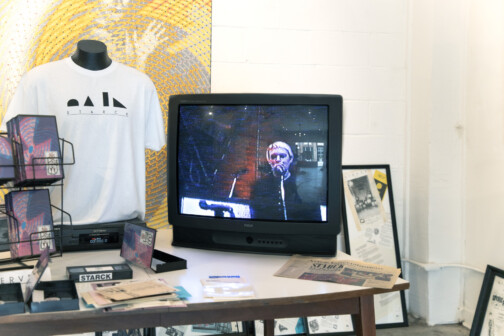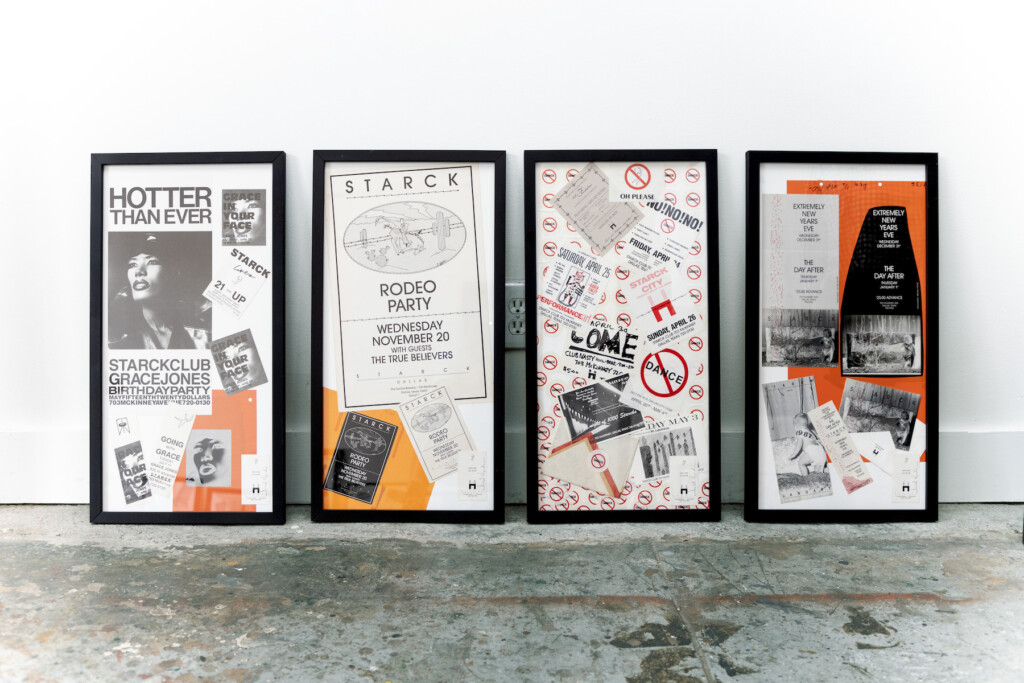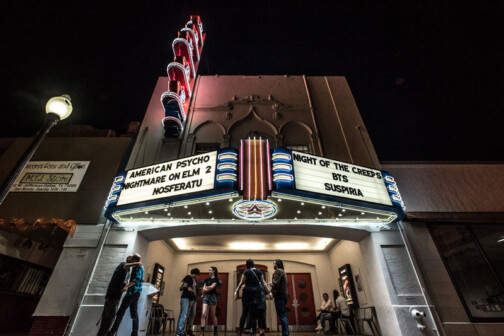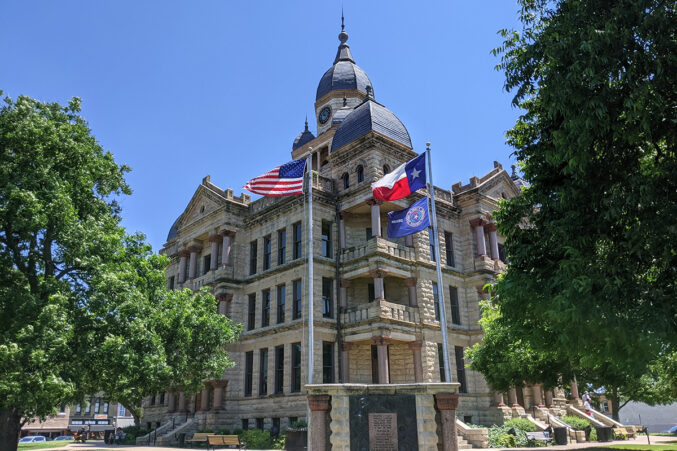In terms of pure Dallas mythology, perhaps no place encapsulates the shorthand idea of the city better than the Starck Club, which this year celebrates its 40th anniversary. A former warehouse in the West End near a very active train yard, the Starck forged inebriated glamour from the ugly and the mundane. The building was once a brewery in the late 1800s before it became storage for the Great Atlantic & Pacific Tea co., at one time a ubiquitous grocer.
The transformation of the building is another take on the tale that the city tells itself—that it came entirely from nowhere before becoming a massive financial hub. That it was built on nothing but the plains and a crooked river that was tidied up by city leadership, unsnarled, and straightened. The names, faces, and contributions that make these commercial and cultural acts of alchemy possible often get lost in these stories.
There are multiple documentaries and countless articles written about the downtown nightclub, most dedicated to its various controversies. While seemingly apolitical, the Starck had an air-tight and fully realized brand identity that was a key to its success and longevity, much of it thanks to the bespoke furniture and layout that was the linear genius and industrial sci-fi aesthetic of its namesake designer, Phillipe Starck.
The logos, themes, posters, and future-leaning video art that played at the club, however, were made by a very different team of people: A small Dallas family that was then-married couple David Hynds and Suzie Riddle. They also brought along their infant daughter, Cecil. She slept in a crib in the state-of-the-art video office where the couple practically lived during the original life of the Starck Club. The office was hidden underneath the stairs, originally placed so that smoke could billow across the dance floor but was eventually scrapped. That proved to be too much flair, even for the Starck.
An art show opening in East Dallas this month revisits some of the elements that contributed to the Starck’s legend. Dozens of hours of footage from the club, themed visual details, and oft-bootlegged fashion items will be on display for three weeks in May. A relatively new gallery called Ephemeral Space is hosting the event, a spot focused on outsider art or “work by Folk artists, Self Taught artists and contemporary art work” according to its mission statement and its own styling. This may be an example of insider art.
Ephemeral Space is run by former Forbidden Books founder Jason Cohen. This magazine once described the shop as such: “It’s the kind of place your mother doesn’t want to know you know about, filled with the sort of books people like to have banned.”
The work that Hynds and Riddle did for the Starck has been lost in the fascination with lurid tales of drug raids, although they had front-row seats for that, too.
Riddle remembers the moment she realized something was awry at her office. She was down in the basement with their child and her husband was on the club floor before doors opened.
“I hear a bunch of screaming,” Riddle said. “I’m hearing the music stop. I’m thinking Oh my god, I thought we were being robbed or something. I had no idea what was going on. I was really scared. It occurred to me it could possibly be some sort of raid or something. I didn’t know what to do so I took my child and I was afraid if I got arrested or something I would be separated from my child and I didn’t want that to happen so I went out the door.”
Riddle escaped to the shared space that the Starck had with Newport’s, the seafood restaurant next door. An employee there informed her that the Starck was being raided and agreed to walk out with Riddle from the restaurant side.

Hynds remembers finding it difficult to explain to a police officer that a baby was in the night club.
“Somebody came out and said, ‘Everybody has to leave,’” Hynds said. “Anybody left inside has been arrested. And if you stay in the parking lot you will be arrested too … and I went, ‘My infant daughter is in there with my wife.’ And he said, ‘Well, they’ve been arrested.’ I said ‘you arrested an infant?’
Hynds eventually saw his wife and child and they went home without incident. The police search the video office but find nothing, although they leave it ransacked. The Starck is forced to shut down any dancing in the venue for two weeks, which leads to a number of “No Dancing” events. Those materials are on display at the gallery.
The champagne soirees for the ultra-wealthy and politically connected remain alluring surface-level trope that has shrouded something more compelling and immortal. Legitimate art was made there for years with great care. The art output that made the Starck was on par with the avant-garde galleries of 1980s New York, and the romanticized dance scenes of Britain from the same era. The club had direct symbiotic connections to both.
Take it from no less an authority than a founding member of New Order and Joy Division, Bernard Sumner. His two earth-shaking groups were on Factory Records, which owned the even more revered Hacienda Club in Manchester. “A club, a legend, a money pit, and for a while, a way of life,” is how Sumner describes the venue that started the Acid House movement, and his words apply here. Sumner credits Dallas for one particular overseas export, as he revealed in his 2014 autobiography, Chapter and Verse:
“We’d played a gig in Dallas, gone out to a club afterwards and got talking to the promoters. These were the days when Dallas was massive on the television and they told us that some members of the cast and crew would go to this club ‘where they liked to drop an E.’
‘What do you mean?’ we said, baffled. ‘What’s an E?’
The drug Ecstasy,’ they replied. ‘Haven’t you heard of it?’
We hadn’t. They told us all about it and how the club had been busted a few weeks earlier. When the lights came up, the police found something like a thousand tabs of E that had been hastily discarded on the floor. Ecstasy hit America as early as 1982, but apparently had not spread much further than this little scene we’d found in Texas. Ecstasy arrived in Britain about five years later and we soon realized it was the same drug we’d heard about in Dallas.”
“Before Ibiza, there was Southfork,” quipped Rolling Stone’s Rob Sheffield while quoting the same book in a piece on the television show’s reunion seasons.
The draconian behavior of authorities toward nightclubs, music, and dance events going back to the jazz age has never entirely gone away. To this day, there are still pearl-clutching developers and property owners attempting to blame anything that goes wrong on so-called “raves.” While the quirky little family that ran the Starck’s art department witnessed the very police raid described by Sumner, Hynds saw the spot as transcending its associations.

“Starck is thought of as like a dance place for the rich and hard to get in and picky at the door and stuff like that,” Hynds said, while arranging the layout of the gallery show at Ephemeral. “But it was really very broad.”
A Chicago area native, Hynds’ brother Tom convinced him that North Texas was going to be the next great film capital, by way of the Studios at Las Colinas. “I was going to film school. And so he kept on saying, it’s going to be the Third Coast coming to Dallas. And you can do film and video here. So he talked me into coming down here. And so I moved here in ’81.”
He came to town and ended up falling into the punk scene, watching new wave acts such as Orchestral Manoeuvres in the Dark play at places such as The Hot Klub, which was once on Maple Avenue and is now Marty’s Live.
Video art was still a form attempting to be taken seriously in the early 1980s. Much like William Eggleston trying to get the art world to accept color photography, new technologies are often viewed with suspicion by formalists and classicists, who frequently hold positions of power. But Dallas became a hot spot for video art during this era, by way of the work being shown at The Starck but also venues such as On the Air and Video Bar.
The Starck’s art department—Hynds and Riddle—traveled to The Kitchen in New York for a media exchange like an analogue tape spice trade. The Kitchen was linked to towering figures such as the late pioneering Korean multimedia artist Nam June Paik, honored last year as part of a screen-forward retrospective at The Fort Worth Modern, and singular 20th Century composer John Cage. Both the Starck and The Kitchen were ahead of the curve on taking video seriously as a medium.
That these young artists were given a long creative leash for such a high-profile business is remarkable. The work was allowed to be displayed mostly unfettered even if the bosses didn’t always get it.
In an interview for the website Memories of Dallas in 2019, former Starck manager Greg McCone described the work as he remembers it:
“In the bathrooms, there are no light fixtures but walls of light from ceiling to floor. There was only an 11-inch TV over the toilet showing videos that we make, which are nonsense videos. For an example, David would lay in the back of a pickup truck and leave Dallas and Suzie would drive to Waco and he’d take pictures of the telephone lines as they went by for 200 miles. Occasionally, you’d see a bird. Crazy, you know?”
Suzie Riddle grew up in Stillwater, Oklahoma before relocating to Dallas for her last two years of high school. She spent some time at the University of Texas at Austin’s film school. The work of experimental filmmakers such as Kenneth Anger and Maya Deren drew her to a fine arts setting as opposed to the tech-forward style that was prevalent at UT at the time. Riddle then says she went to “seek my fortune elsewhere but ended up working at the Starck Club for a while and then raising my kids there for 30 years.”
She describes herself as someone scribbling poetry in the corner, not the center of attention.
“I said to myself the best job would be to be someplace where I could show films and there would always be a party going on but I can kind of be off to myself, but then come down to the party every time I felt like it,” Riddle said.

Riddle was a year ahead of Austin director Richard Linklater, who went on to become one of the state’s most prominent filmmakers.
“I had been immersed in the experimental film/short film scene in Austin, which was kind of where Rick Linklater grew out of that as well, all these film/punk nerd people,” Riddle said.
“I didn’t know Rick, he came right after me. We actually did know him because we corresponded, by the Starck Club, back when he had the Film Society. But he wasn’t famous back then. He was just a Texas film guy.”
In addition to its internationally recognized DJs and live acts, the club also hosted unexpected events such as a private party for the 1984 Republican Convention and the Dallas Ballet. All the more surprising considering the amount of transgressive punk and queer activity during the lifetime of the establishment.
“You asked about the political sway, it was like what is interesting? What is new? What’s going on in the culture?” said Hynds.
“The Starck Club was not really the punk scene, but it was being orbited by all the same kind of artsy people,” Riddle said.
In fact, the Starck had someone known as “the queen of punk” running its mercurial door policy. That was according to Facade Magazine. Edwige Belmore shared that cover story with Andy Warhol. Belmore had a band called Mathémathiques Modernes. The coldwave group had a single called “Disco Rough” that was celebrated in the British music press at the time. It has been called “one of the 100 greatest disco singles of all time.”
These photographs, posters, and keepsakes show that Dallas, as much as any big city in the tumultuous second half of the 20th Century, has an artistic past worth celebrating. Manchester may have had Morrissey and Madonna at the Hacienda and New York had everything. But it should be remembered that Grace Jones, Stevie Nicks, Trouble Funk, SPK, Chris & Cosey, and many more performed at the Starck Club.
While walking through the gallery, Hynds casually mentions he has video of Edwige Belmore performing a soundcheck at the club, which he sometimes uses as closing filler for the Starck highlights he sells on VHS. There is almost no known live footage of the fabled Mathémathiques Modernes online. A video like that can go wildly viral as today’s youth search for anything authentically ’80s. All the blues murals and acknowledgements throughout the city are great and necessary, but the actual past is much more complex, out there, and progressive. The city center should also have a wall-sized tribute to the likes of Edwige Belmore and our cyber punk past. As much money passes through Dallas, it doesn’t ever seem to know just how rich it really is.
Hynds seems to recognize the artistic expression that was encouraged in the city for a time.
“There were a lot of people who were just there doing bartending or waiting and stuff, and but anybody who had ideas could bring [them] forward and a lot of it, again, folded into what we were doing at the club,” Hynds said. “So yeah, it was a pretty amazing place, I think. Most people—I’m speaking for a lot of people—but I think a lot of people who work there would say it was the best job they ever had. It was the best job I have ever had. After that it was like, how am I gonna get that again?”
“Starck Art” runs through May 18 at Ephemeral Space, located at 203 S. Haskell Ave. Ste. B. Dallas. A 40th Anniversary show for the Starck Club featuring Lithium X-mas will take place at the Kessler Theater on May 12. The show is sold out. Details here.
Author








